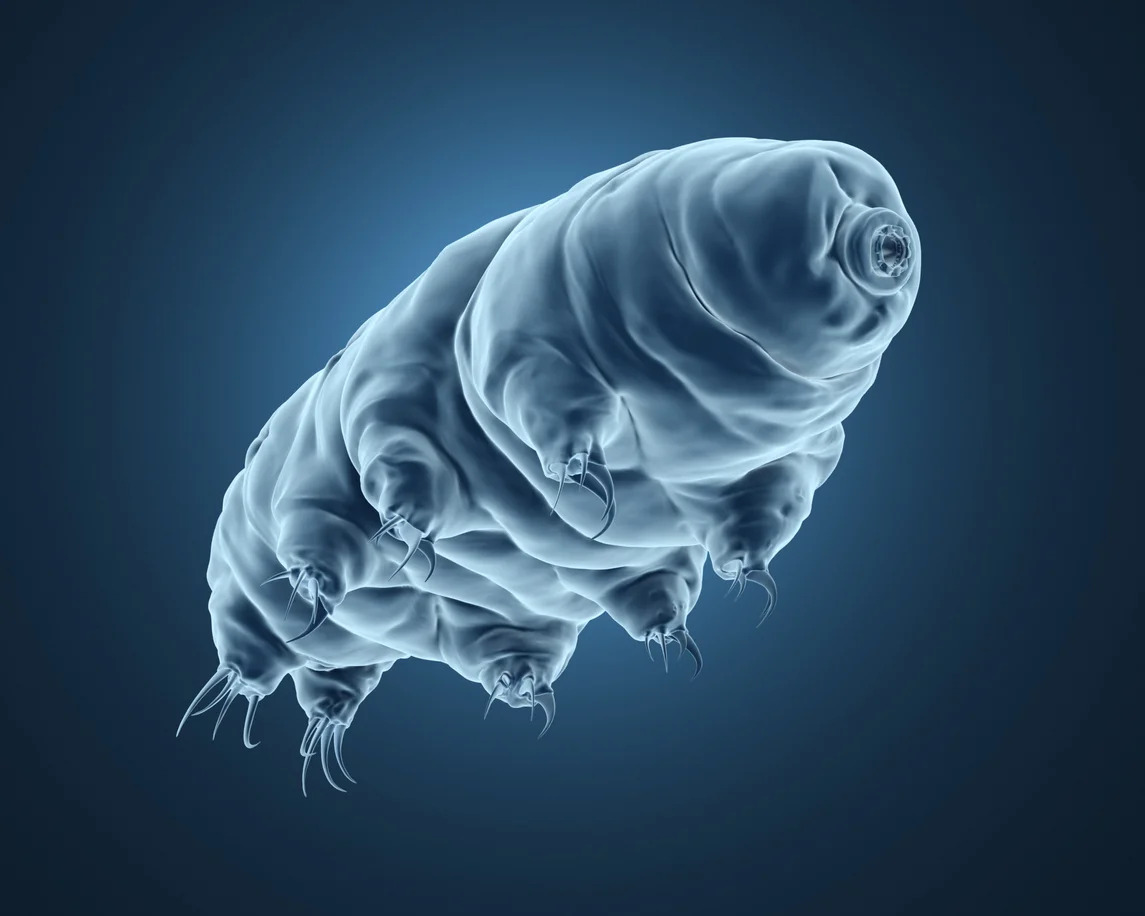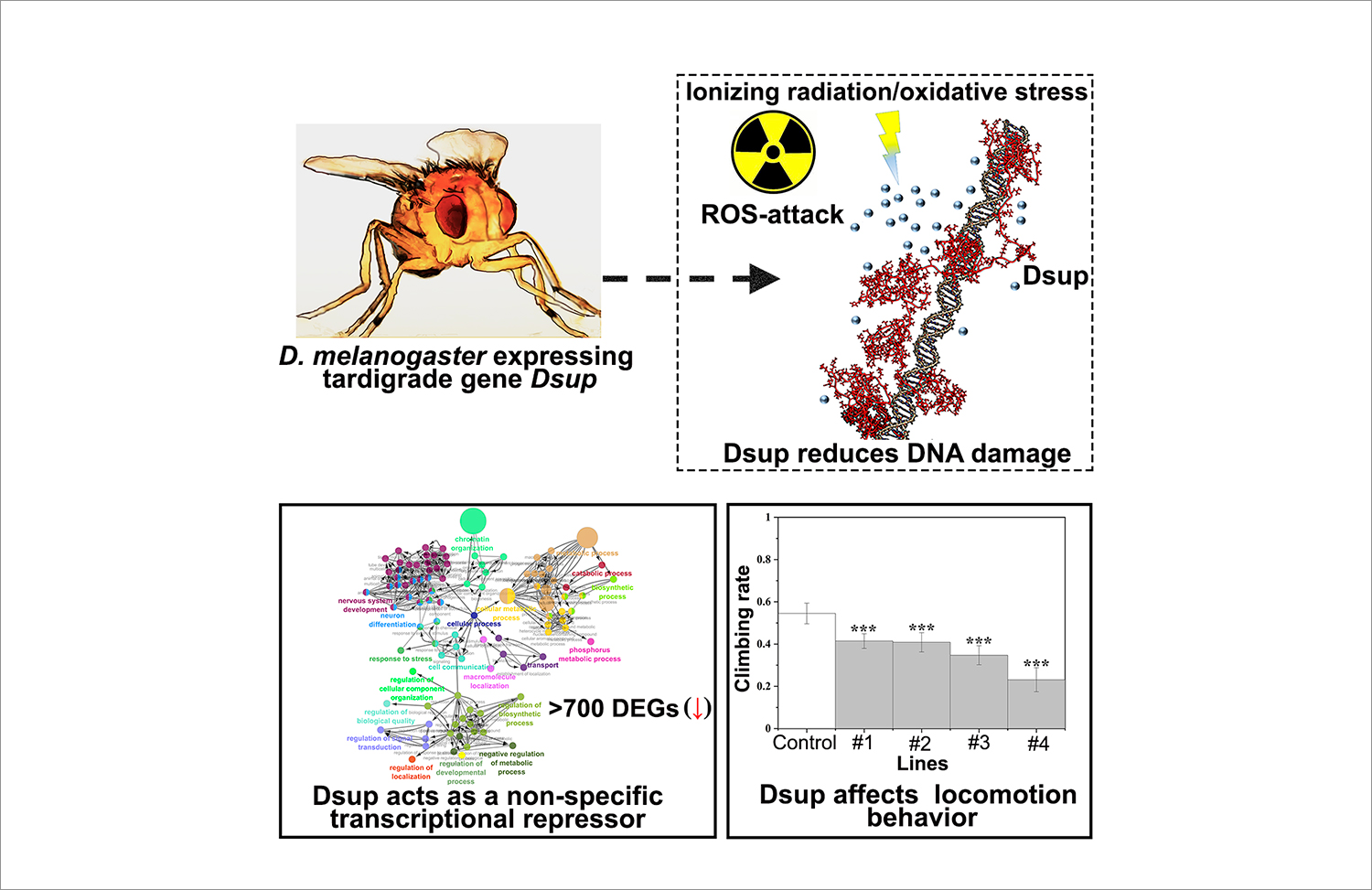Protein of tardigrades increased resistance of flies to radiation, but made them slower
News, 13 June 2023
Scientists of the Sector of Molecular Genetics of the Cell of the Dzhelepov Laboratory of Nuclear Problems JINR have managed to increase the resistance of fruit flies and human cultured cells to radiation and oxidative stress using the unique damage suppressor protein of tardigrades (Dsup). Experiments conducted at JINR prove the hypothesis about the action mechanism of proteins of tardigrades and could open up new possibilities in the fields of biotechnology, pharmaceuticals, and oncology. However, there is a downside, namely the mutation has impacted on cell processes connected to DNA and RNA, resulting in the reduction of the level of locomotor activity of laboratory flies at long distances. The results of the study by DLNP JINR scientists have been published in iScience, a prestigious scientific journal.
The study of molecular mechanisms of extreme tolerance of living organisms to various types of stress is one of the promising areas of modern molecular biology, biophysics, astrobiology, and synthetic biology. The obtained results could be a basis for new solutions in medicine, biotechnology, pharmaceuticals, and cosmonautics. Tardigrades, in particular, are representatives of the Ramazzotius varieornatus species. They are one of the most stress-resistant animals on Earth. Experiments with these invertebrates have revealed their ability to survive prolonged drying periods, endure in toxic environments, under the exposure to huge doses of radiation (>5,000 Gy), being in outer space, etc. Unique disordered proteins (TDPs), including the Dsup protein discovered in 2016 by Japanese scientists, play one of the key roles in the resistance of tardigrades to various types of stress. Since 2020, DLNP JINR scientists have been studying the Dsup protein of tardigrades in vivo in model organisms such as a Drosophila melanogaster fruit fly and human cultured cells. At the same time, to decipher the molecular mechanisms of its action, specialists are studying the molecular structure of the Dsup protein and its complex with DNA.
Experiments by JINR biologists have shown that the genetic insertion of the Dsup protein significantly increases the survival rate of the D.melanogaster complex model organism after γ-ray irradiation at doses of 500-1000 Gy and oxidative stress treatment. Previously, a group of researchers suggested that the Dsup protein formed a protective shield around DNA, taking on part of the radiation impact. Thus, it protects DNA better and increases the survival rate. Experiments conducted in DLNP JUNR confirm this hypothesis. Analysis of the activity of all genes (transcriptomic analysis) and physiological tests have revealed the impact of the Dsup protein on a number of processes in D.melanogaster . In particular, flies began to fly slower at long distances. Scientists attribute this to a slowdown in cellular processes in DNA and RNA in the presence of the Dsup protein.
 Head of research in DLNP JINR Elena Kravchenko
Head of research in DLNP JINR Elena Kravchenko
“In addition to such an undeniably positive effect as an increase in radioresistance, the Dsup protein has side effects connected to a gradual slowdown of a number of fast processes. For example, flies with superpowers fly as fast as control ones at short distances. However, they began to fly slower at long distances. It is not very critical for bacteria, plants, and farm animals. However, if we consider the application of these experiments for the preparation for flights into deep space, where one of the main limiting factors is cosmic radiation, then it is necessary to develop a scheme, in which the Dsup protein will work only when it is required, not all the time as in developed models. This will allow almost completely getting rid of side effects. Our group is already developing such a system,” Head of the research, Head of the DLNP JINR Sector of Molecular Genetics of the Cell, a candidate of biological sciences Elena Kravchenko.
“Our studies of the Dsup protein of tardigrades are expanding the understanding of the role of naturally disordered proteins such as DNA protective molecules in extremophilic organisms and even human cells. However, the model of the protective mechanism remains incomplete without our study of the structural properties of the Dsup protein and its complex with DNA,” a junior researcher of the DLNP Sector of Molecular Genetics of the Cell Mikhail Zarubin notes.
 A participant of experiments Mikhail Zarubin
A participant of experiments Mikhail Zarubin
Among the possible applications, authors of the research suggest the creation of radioresistant strains of organisms for biotechnology and bioremediation of soils and waters, the development of an agent for cryopreservation and long-term storage of pharmaceuticals and vaccines, the protection of healthy tissues during irradiation during cancer therapy, etc.

